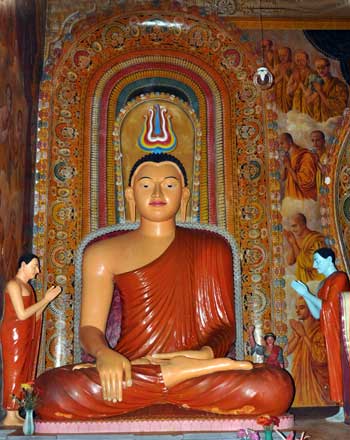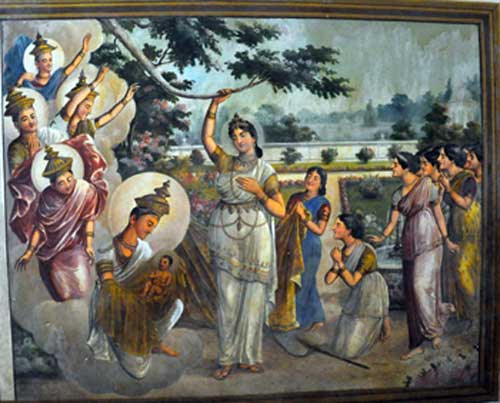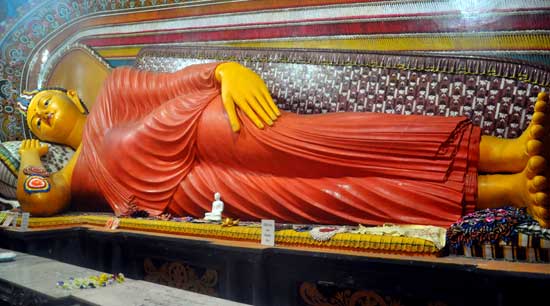The significance of Vesak
Vesak stands as the most significant religious festival for Buddhists globally, a time of profound reflection and celebration. This sacred day uniquely commemorates the three fundamental milestones in the life of Siddhartha Gautama, the Buddha: his auspicious birth, his supreme enlightenment under the Bodhi tree achieving Nirvana, and his peaceful passing into Parinirvana.
The convergence of these three pivotal events on the same full moon day of the lunar month of Vesak, typically aligning with May in the Gregorian calendar, underscores the extraordinary nature of this occasion. For Buddhists, Vesak is not merely a historical remembrance but a vibrant opportunity to connect with the very essence of their spiritual tradition and the transformative journey of the Buddha.


The Birth,Enlightenment and Parinirvana as depicted at the Isipathanaramaya in Colombo. Pix by Priyanka Samaraweera
The observance of Vesak is marked by various devotional practices and acts of merit. Buddhists around the world engage in temple visits, offering prayers, chanting sacred texts, donations to those in need, and listening to sermons that reiterate the Buddha’s teachings on compassion, mindfulness, and the path to liberation. Acts of kindness and generosity are also central to Vesak celebrations, with many Buddhists participating in charitable activities, releasing animals, and abstaining from consuming meat. This collective engagement in spiritual and ethical practices during Vesak serves as a powerful reminder of the core values of Buddhism and fosters a sense of unity and shared purpose within the global Buddhist community.
Commemorating the Birth of Siddhartha Gautama
The commemoration of the Buddha’s birth during Vesak holds profound significance as it marks the pivotal beginning of Buddhism. In Lumbini, Nepal, the birth of Prince Siddhartha Gautama heralded the arrival of an extraordinary individual destined to illuminate the path to liberation for countless beings. This foundational event is not merely a historical footnote; it represents the genesis of a spiritual tradition that has profoundly influenced the world, offering a framework for understanding suffering and achieving inner peace. The celebration of this birth on Vesak serves as a powerful reminder of the potential inherent in every individual to embark on a journey of self-discovery and enlightenment.
Reflecting on the Buddha’s birth during Vesak inspires a sense of gratitude and hope within the Buddhist community. It underscores the preciousness of human life and the opportunity it presents for spiritual growth and the pursuit of wisdom. This commemoration is a time to remember the circumstances surrounding his birth, often depicted with miraculous elements signifying his unique destiny. By honouring this event, Buddhists connect with the very origins of their faith, drawing inspiration from the initial step on the path that ultimately led to the dissemination of the Dharma, the Buddha’s teachings, for the benefit of all sentient beings.
Celebrating Enlightenment
The commemoration of Siddhartha Gautama’s enlightenment under the Bodhi tree in Bodh Gaya, India, during Vesak, stands as the very heart of Buddhist observance. This transformative experience marked his awakening from ignorance and the profound realization of the Four Noble Truths: the truth of suffering, the truth of the origin of suffering, the truth of the cessation of suffering, and the truth of the path to the cessation of suffering. This pivotal moment is not just a historical event; it is the very essence of the Buddhist path, representing the attainment of Nirvana, the ultimate liberation from the cycle of suffering and rebirth. Buddhists worldwide look to this event as the ultimate aspiration and the guiding light on their own spiritual journeys.
Vesak celebrations actively recall the significance of the Buddha’s enlightenment, emphasizing its central role in the Buddhist understanding of reality and the potential for all beings to achieve the same awakening. The Four Noble Truths, realized in that profound moment, provide the foundational framework for Buddhist philosophy and practice, offering a clear diagnosis of the human condition and a practical path towards healing. By reflecting on the Buddha’s enlightenment, practitioners are inspired to cultivate wisdom, ethical conduct, and mental discipline, striving to understand the nature of reality and ultimately transcend suffering, just as the Buddha did under the Bodhi tree.
Remembering the Parinirvana
The commemoration of the Buddha’s Parinirvana on Vesak, his passing away in Kushinagar, India, holds a unique place within Buddhist observance. While marking the cessation of his physical presence, this event is not approached with traditional grief. Instead, it serves as a potent reminder of the universal truth of impermanence (anicca), a core tenet of Buddhist philosophy. The Buddha’s final passing underscores the transient nature of all compounded phenomena, encouraging practitioners to release attachments and cultivate a deeper understanding of reality.
Reflecting on the Parinirvana during Vesak inspires a focus on the enduring legacy of the Buddha’s teachings (Dharma) and the potential for attaining ultimate peace (Nirvana). It highlights that while the physical form is subject to decay, the wisdom and compassion embodied in his teachings continue to guide countless individuals on the path to liberation. This commemoration encourages Buddhists to persevere in their practice, knowing that the ultimate peace experienced by the Buddha is also attainable by those who diligently follow the path he illuminated. Vesak, therefore, becomes a time to both acknowledge the impermanent nature of existence and to reaffirm faith in the transformative power of the Dharma.
Reflection, renewal and merit-making during Vesak
Beyond the commemoration of the Buddha’s birth, enlightenment, and passing, Vesak holds significant importance as a dedicated period for profound reflection and spiritual renewal for Buddhists across the globe. This sacred time encourages individuals to delve deeply into the core tenets of the Buddha’s teachings, particularly emphasizing the cultivation of compassion (karuna), loving-kindness (metta), peace (shanti), and tolerance (khanthi). By contemplating these virtues, practitioners are inspired to examine their own lives and strive to embody these principles more fully in their thoughts, words, and actions. Vesak, therefore, serves as an annual opportunity to refresh one’s spiritual commitment and to realign with the ethical and philosophical foundations of Buddhism.
The observance of Vesak is also deeply intertwined with the practice of merit-making and engaging in good deeds. Throughout this auspicious time, Buddhists actively participate in various meritorious activities believed to purify the mind and cultivate positive karma. These actions often include visiting temples to offer prayers and pay respects, generously donating to charitable causes, and in some traditions, symbolically releasing animals as an act of compassion. Furthermore, many Buddhists choose to abstain from consuming meat during Vesak, aligning with the principle of non-violence and reverence for all life. These collective acts of kindness and generosity underscore the practical application of Buddhist values and foster a sense of interconnectedness and responsibility within the community.
Unity, global recognition and the essence of Vesak
Vesak plays a crucial role in fostering unity and strengthening the bonds within the Buddhist community, encompassing both the monastic order (the Sangha) and lay followers. The shared observance of this significant day brings people together in temples and community centres, creating a powerful sense of belonging and shared faith. Through collective participation in ceremonies, rituals, and social gatherings, individuals reinforce their connection to the Dharma and to one another. This communal aspect of Vesak provides mutual support and encouragement on the spiritual path, highlighting the importance of Sangha as a source of guidance and inspiration.
The international recognition of Vesak Day by the United Nations in 1999 further amplifies its global significance, underscoring the profound and enduring contribution of Buddhism to the spiritual heritage of humanity. By officially recognizing Vesak, the UN highlights the universal values of peace, compassion, and wisdom that are central to the Buddha’s teachings and their relevance in addressing contemporary global challenges. This international recognition not only honours the Buddhist tradition but also promotes interfaith understanding and appreciation for the shared human aspiration for peace and well-being.
In essence, Vesak stands as the most profoundly sacred day in the Buddhist calendar, a time when followers across the world converge in remembrance, celebration, and deep reflection upon the three pivotal milestones in the Buddha’s life: his birth, his enlightenment, and his Parinirvana. This auspicious occasion serves as a powerful annual reminder of the extraordinary journey of Siddhartha Gautama and the transformative teachings he imparted. More importantly, Vesak is a dedicated period for Buddhists to reaffirm their personal commitment to the path he illuminated – a path leading towards the cessation of suffering and the ultimate attainment of inner peace and liberation.
(The writer is Emeritus Professor in Economics, University of Colombo)
Searching for an ideal partner? Find your soul mate on Hitad.lk, Sri Lanka's favourite marriage proposals page. With Hitad.lk matrimonial advertisements you have access to thousands of ads from potential suitors who are looking for someone just like you.


